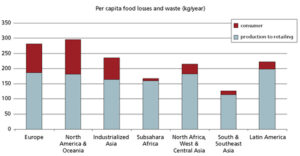SAVE FOOD: Global Initiative on Food Loss and Waste Reduction
04 Aug 2023Key Findings
- Roughly one third of the food produced in the world for human consumption every year — approximately 1.3 billion tonnes — gets lost or wasted.
- Food losses and waste amounts to roughly US$ 680 billion in industrialized countries and US$ 310 billion in developing countries.
- Industrialized and developing countries dissipate roughly the same quantities of food — respectively 670 and 630 million tonnes.
- Fruits and vegetables, plus roots and tubers have the highest wastage rates of any food.
- Global quantitative food losses and waste per year are roughly 30% for cereals, 40-50% for root crops, fruits and vegetables, 20% for oil seeds, meat and dairy plus 30% for fish.
- Every year, consumers in rich countries waste almost as much food (222 million tonnes) as the entire net food production of sub-Saharan Africa (230 million tonnes).
- The amount of food lost or wasted every year is equivalent to more than half of the world’s annual cereals crop (2.3 billion tonnes in 2009/2010).
- Per capita waste by consumers is between 95-115 kg a year in Europe and North America, while consumers in sub-Saharan Africa, south and south-eastern Asia, each throw away only 6-11 kg a year.
Per capita food losses and waste, at consumption and pre-consumptions stages,
in different regions

- Total per capita food production for human consumption is about 900 kg a year in rich countries, almost twice the 460 kg a year produced in the poorest regions.
- In developing countries 40% of losses occur at post-harvest and processing levels while in industrialized countries more than 40% of losses happen at retail and consumer levels.
- At retail level, large quantities of food are wasted due to quality standards that over-emphasize appearance.
- Food loss and waste also amount to a major squandering of resources, including water, land, energy, labour and capital and needlessly produce greenhouse gas emissions, contributing to global warming and climate change.
- The food currently lost or wasted in Latin America could feed 300 million people.
- The food currently wasted in Europe could feed 200 million people.
- The food currently lost in Africa could feed 300 million people.
- Even if just one-fourth of the food currently lost or wasted globally could be saved, it would be enough to feed 870 million hungry people in the world.
- Food losses during harvest and in storage translate into lost income for small farmers and into higher prices for poor consumers.
- In developing countries food waste and losses occur mainly at early stages of the food value chain and can be traced back to financial, managerial and technical constraints in harvesting techniques as well as storage and cooling facilities. Strengthening the supply chain through the direct support of farmers and investments in infrastructure, transportation, as well as in an expansion of the food and packaging industry could help to reduce the amount of food loss and waste.
- In medium- and high-income countries food is wasted and lost mainly at later stages in the supply chain. Differing from the situation in developing countries, the behaviour of consumers plays a huge part in industrialized countries. The study identified a lack of coordination between actors in the supply chain as a contributing factor. Farmer-buyer agreements can be helpful to increase the level of coordination. Additionally, raising awareness among industries, retailers and consumers as well as finding beneficial use for food that is presently thrown away are useful measures to decrease the amount of losses and waste.
Was this article helpful?
3398
295